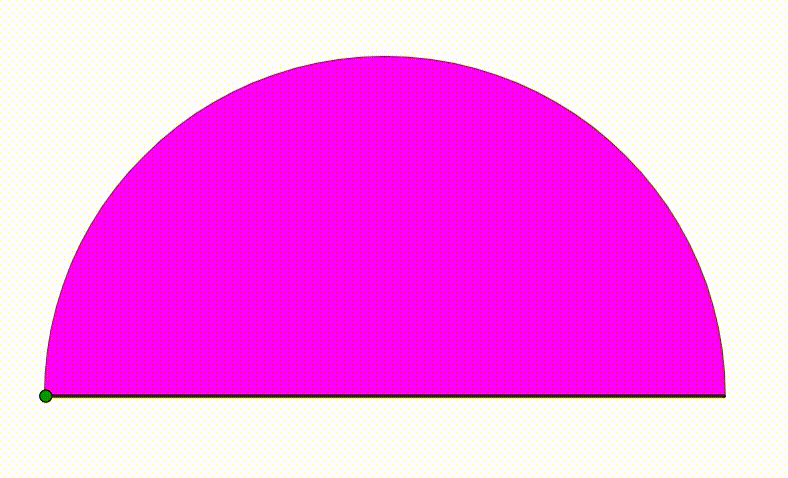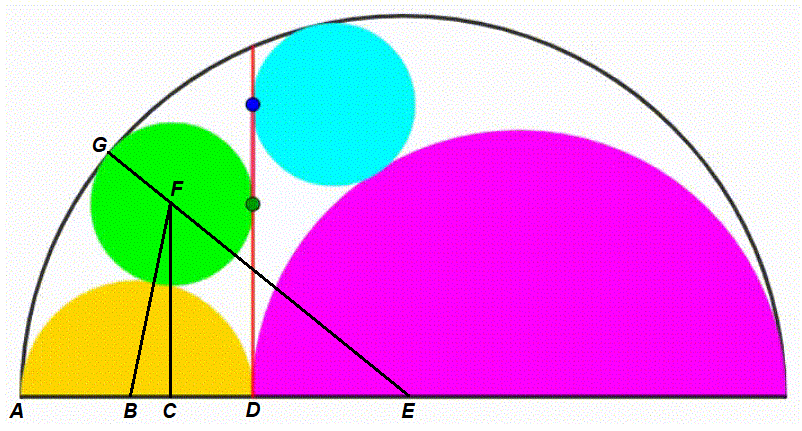Dynamic Geometry: P32
 The diagram shows a black semicircle. The pink and yellow semicircles are tangent to each other and internally tangent to the black semicircle. They are growing and shrinking freely so that the sum of their radius is always equal to the black semicircle's radius. We draw a red vertical segment using the common point between the pink and yellow semicircle. At last we inscribed two circles (green and cyan) so they are tangent to the red line, to the black semicircle and to one of the two bottom semicircle. The green and blue point are the intersection points between the red segment and the circles. When the distance between the blue and green point is
maximum
, the fraction of the white area can be expressed as
b
a
where
a
and
b
are coprime positive integers. Find
a
+
b
.
The diagram shows a black semicircle. The pink and yellow semicircles are tangent to each other and internally tangent to the black semicircle. They are growing and shrinking freely so that the sum of their radius is always equal to the black semicircle's radius. We draw a red vertical segment using the common point between the pink and yellow semicircle. At last we inscribed two circles (green and cyan) so they are tangent to the red line, to the black semicircle and to one of the two bottom semicircle. The green and blue point are the intersection points between the red segment and the circles. When the distance between the blue and green point is
maximum
, the fraction of the white area can be expressed as
b
a
where
a
and
b
are coprime positive integers. Find
a
+
b
.
The answer is 95.
This section requires Javascript.
You are seeing this because something didn't load right. We suggest you, (a) try
refreshing the page, (b) enabling javascript if it is disabled on your browser and,
finally, (c)
loading the
non-javascript version of this page
. We're sorry about the hassle.
2 solutions
Thank you for posting you solution, I really like this set up
Log in to reply
Please add a full-stop (period) at the end of your question. "Find a + b . ".
Ok Corrected.
Label the diagram as follows:

Let the radius of the black semi-circle be 1 , the radius of the yellow semi-circle be r , the radius of the green circle be s , and ∠ F B C be θ .
Since B C = B D − C D = r − s and B F = r + s , from △ B C F we know that cos θ = B F B C = r + s r − s .
Since B E = A E − A B = 1 − r , F E = G E − G F = 1 − s , and B F = r + s , by the law of cosines on △ B E F we know that cos θ = 2 ⋅ B E ⋅ B F B E 2 + B F 2 − F E 2 = 2 ⋅ ( 1 − r ) ⋅ ( r + s ) ( 1 − r ) 2 + ( r + s ) 2 − ( 1 − s ) 2 = ( 1 − r ) ( r + s ) r 2 + r s − r + s .
Therefore, cos θ = r + s r − s = ( 1 − r ) ( r + s ) r 2 + r s − r + s , which solves to s = r ( 1 − r ) .
By the Pythagorean Theorem on △ B C F , C F = B F 2 − B C 2 = ( r + s ) 2 − ( r − s ) 2 = 2 r s . Substituting s = r ( 1 − r ) gives C F = 2 r 1 − r , which is also the height of the green dot.
Let the radius of the pink semi-circle be q and the radius of the cyan circle be t .
Then by similar arguments as above, t = q ( 1 − q ) and the height of the blue dot will be 2 q 1 − q .
From the diameter of the black semi-circle, 2 r + 2 q = 2 , which solves to q = 1 − r .
Substituting q = 1 − r into t = q ( 1 − q ) and 2 q 1 − q gives t = r ( 1 − r ) = s and a blue dot height of 2 ( 1 − r ) r .
The distance between the blue and green point is then y = 2 r 1 − r − 2 ( 1 − r ) r , which reaches a maximum when its derivative is equal to 0 , or when d r d y = r ( 1 − r ) r ( 2 − 3 r ) + 1 − r ( 3 r − 1 ) = 0 , which solves to r = 6 3 ± 5 .
If r = 6 3 ± 5 , then q = 1 − r = 6 3 ∓ 5 , and s = t = r ( 1 − r ) = 9 1 .
The fraction of the white area is then 2 1 π 1 2 2 1 π 1 2 − ( 2 1 π q 2 + 2 1 π r 2 + π s 2 + π t 2 ) = 1 − q 2 − r 2 − 4 s 2 = 1 − ( 6 3 ∓ 5 ) 2 − ( 6 3 ± 5 ) 2 − 4 ( 9 1 ) 2 = 8 1 1 4 .
Therefore, a = 1 4 , b = 8 1 , and a + b = 9 5 .
Thank you for posting (your going absolutely berserk aha). It's funny how your approach is totaly different from mine.
Log in to reply
I'm iced in this morning so I'm enjoying some unexpected free time writing some math solutions :-)
I would love to see your approach!
Log in to reply
My solution involves coordinates geometry, no trigonometry. I shall post it when I get the time...too much problems to post ;}
What is the difference between ± and ∓ ?
Log in to reply
If you positive on one then you use negative on the other, and vice versa. So in this problem, if you use r = 6 3 + 5 then you would use q = 6 3 − 5 , but if you use r = 6 3 − 5 then you would use q = 6 3 + 5 .
Let the center of the large semicircle be O ( 0 , 0 ) , the origin of the x y -plane and its radius 1 . Let the red line be x = u , the radii of the pink, yellow, cyan, and green circle be r 1 , r 2 , r 3 , and r 4 respectively. Let the centers of the cyan and green circles be P ( x p , y p ) and Q ( x q , respectively. Then the distance between the blue and green points D = ∣ y p − y q ∣ . We note that x p = u + r 3 and y p = ( r 1 + r 3 ) 2 − ( r 1 − r 3 ) 2 = 2 r 1 r 3 . Similarly, x q = u − r 4 and y q = 2 r 2 r 4 .
Let us find the four radii in terms of u . r 1 = 2 1 − u , r 2 = 2 1 + u , and
x p 2 + y p 2 ( u + r 3 ) 2 + ( 2 r 1 r 3 ) 2 u 2 + 2 u r 3 + r 3 2 + 4 r 1 r 3 u 2 + 2 u r 3 + r 3 2 + ( 2 − 2 u ) r 3 u 2 + 2 r 3 ⟹ r 3 = ( 1 − r 3 ) 2 = 1 − 2 r 3 + r 3 2 = 1 − 2 r 3 + r 3 2 = 1 − 2 r 3 + r 3 2 = 1 − 2 r 3 = 4 1 − u 2 Note that r 1 = 2 1 − u
Similarly, r 4 = 4 1 − u 2 = r 3 . Without loss of generality, assume that y q > y p . Then
D = y q − y p = 2 r 2 r 4 − 2 r 1 r 3 = 2 ( 1 + u ) 1 − u − ( 1 − u ) 1 + u
To find the maximum value of D ,
d u d D 1 + u + 1 − u 2 1 − u 2 ( 1 + u + 1 − u ) 2 1 − u 2 ( 1 + u + 1 − u ) 2 1 − u 2 3 1 − u 2 1 − u 2 ⟹ u = 2 1 ( 1 − u − 2 1 − u 1 + u + 1 + u − 2 1 + u 1 − u ) Putting d u d D = 0 = 2 1 − u 1 + u + 2 1 + u 1 − u = ( 1 + u ) 2 3 + ( 1 − u ) 2 3 Since a 3 + b 3 = ( a + b ) ( a 2 − a b + b 2 ) = ( 1 + u + 1 − u ) ( 1 + u − 1 − u 2 + 1 − u ) = 2 − 1 − u 2 = 2 = 9 4 = 3 5
Therefore D is maximum when u = 3 5 , since minimum D is 0 as can be seen from the animation. Then r 1 = 6 3 − 5 , r 2 = 6 3 + 5 , and r 3 = r 4 = 9 1 . And the fraction of white area:
2 π π ( 2 1 − 2 r 1 2 − 2 r 2 2 − r 3 2 − r 4 2 ) = 2 ( 2 1 − 7 2 1 4 − 6 5 − 7 2 1 4 + 6 5 − 8 1 2 ) = 8 1 1 4
Therefore a + b = 9 5 .